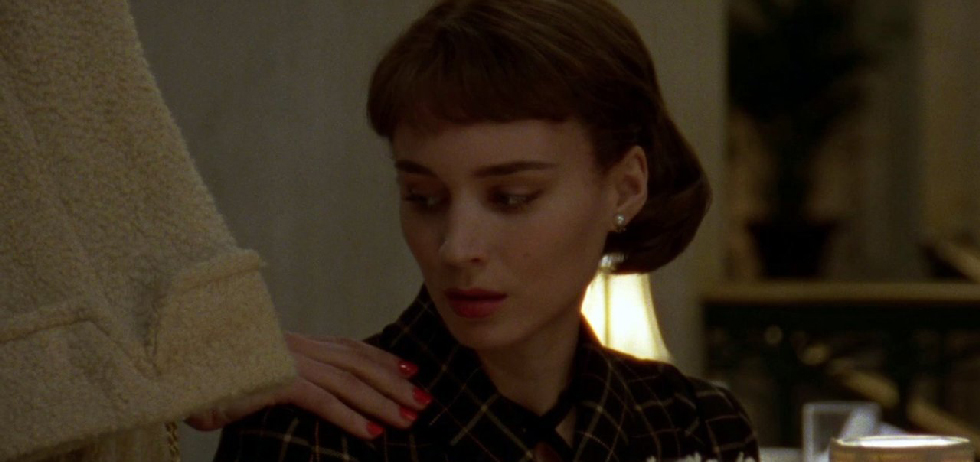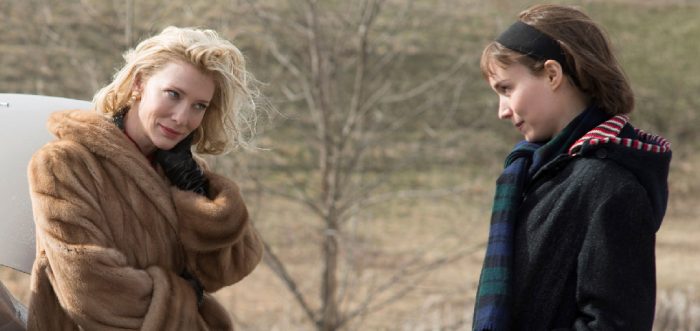
Since its berth at last year’s Cannes Film Festival, Carol has been described by its minority of detractors with a number of pejoratives that don’t necessarily register as such, at least to my eyes: from the standard variety of refrigerator settings (“cold”/”icy”/”frozen”) to “tasteful” through to “dead”. The film is arguably the most straightforward and emotionally accessible in Haynes’ filmography, whose narratives are often either pervaded by formal distanciation (1995’s Safe, his best film to date), layered in semiotic subterfuge (his 2007’s Bob Dylan fantasia I’m Not There) or refracted through a key cinematic ur-text (2002’s Far From Heaven paid extensive homage to Douglas Sirk’s All That Heaven Allows).1
Haynes’ own ur-text, or “skeleton key” film, as identified by critic Dennis Lim, is his debut: 1987’s thesis film Superstar: the Karen Carpenter Story, which recast Carpenter’s tragic life story using Barbie dolls; the kind of signifiers of idealised femininity that played a role in her own downfall. The effect is funny, spooky, and only overly precious in theory rather than execution: a bold experiment that pays off. Reflecting on the film recently, Haynes said, “I was interested in sort of playing out some theories or ideas or questions about narrative structure, and how we identify in stories emotionally… I felt like if we followed a genre very closely, but did it with dolls, and did it very carefully and very lovingly and attentively, it could stimulate emotions in a viewer the way it would if it was actors.”
This kind of academic gamesmanship that pervades Haynes’ filmography to date is admittedly why I went into Carol, on first viewing, with a jaundiced eye. Initially, I found it a lovely aesthetic object (thanks in large part to the 16mm lensing of Ed Lachman), if a little thin, and lacking in emotional heft. But that reaction didn’t sit right with me, partly because it perpetuates a very boring false binary of academic vs. emotional engagement. Instead, that very ‘deadened’ quality that seemed like a mild deficiency on first look turned out to be a suitable entry point on second viewing. Told in flashback through the P.O.V. of its central character Therese Belivet (Rooney Mara) at the possible end of her brief encounter with the eponymous object of desire (Cate Blanchett), Carol is a dispassionate autopsy of an affair, in the vein of Carl Dreyer’s infamously unyielding Gertrud, albeit with more appealing surface textures than Dreyer’s austere swansong.
Accordingly, while the film has been praised for capturing the thrill of mutual attraction escalating into love, this sensation is deliberately muted, or complicated by the vantage point of its narrator – who recalls their relationship in tears, after a breakup over dinner, in the back of a taxi.2 A brief reverie scene at around the midpoint of the film, designed to rhyme with this framing scene, in which Therese sits in Carol’s car as they enter a tunnel is a good example of the film’s ambiguous emotional tenor. Reminiscent of Wong Kar-Wai & Christopher Doyle collaborations3, it takes recognisable objects associated with everyday commute (the lights aligning an underpass, the décor of a car, the sunlight at the end of the tunnel) and reduces them to pure light and color, as the torch song playing on the radio fades on the sound mix and registers like something heard rooms away from the ballroom in The Shining’s Overlook hotel. It’s equally swoony and sinister, and much of the scenes between the two have a similarly eerie, spectral quality, like a later shot of fog reflected in a car windscreen that frames Carol and Therese during a heated argument on a roadside. What Carol captures more specifically than the thrill of a romantic encounter is the act of remembering only to forget; the process of compartmentalising and denying emotions felt in the past that are presently too painful to recall in great detail, even as the coinciding sense-memories still linger vividly.

The first image of Therese’s recollections of the affair sets a tone of repression; a neatly aligned row of dolls in the toy section of her department store workplace, which serves at once as a blunt metaphor of stifling social expectations as well as a (perhaps unintentional) call-back to the dolls of Haynes’ Superstar. This image of blank-slate figurines also dovetails with one of the film’s own subtexts-made-text, of human attraction being likened to “pinballs bouncing off of each other”, visualised in a virtuosic opening crane shot that tracks a man exiting a subway, picked seemingly at random, then following him into a building before he interrupts a fraught moment between Carol and Therese. It’s the kind of narrative and stylistic gesture that frames its two subjects, and their untenable relationship, as being commonplace rather than transgressive, and to Haynes’ credit, nothing in Carol is designed to put a liberal audience in a position of smug superiority towards the attitudes of a bygone era, despite the presence of ostensible ‘bad guys’ like Carol’s husband Harge (Kyle Chandler) and the lawyers involved in finalising their messy divorce.4
Moreso than the much-praised performances of Mara and Blanchett (the former is terrific, while Blanchett is uneven, and mannered in a way that role doesn’t call for; only in the wordless, beautifully ambiguous final scene does her performance truly soar), it’s difficult imagining Carol working half as well without the work of D.P. Ed Lachman, whose alternately lush and scuzzy 16mm lensing gives the film a distinctively subterranean quality. The very first image is of a steel grating outside a subway station, with the flecks of film grain dancing noticeably in the black gaps between the wiring. It’s a powerful illustration of chemical randomness within a fixed structure, and the kind of inspired touch that a truly collaborative effort can yield. At one point in the film, a character watching Sunset Boulevard takes notes during the film, telling Therese that “he’s charting the correlation between what the characters say and what they’re really feeling”, before begin rebutted with “My kid brother here, the Movie Jerk”. This exchange is a marvelous bit of self-effacement of Haynes’ part. You could, indeed, watch Carol and identify its meticulously strategised visual and narrative schema. Fortunately, there’s more to the film than just stuff for the Movie Jerks.
Around the Staff
| Ali Schnabel | |
| Jessica Ellicott | |
| Jaymes Durante | |
| Felix Hubble | |
| Luke Goodsell | |
| Conor Bateman | |
| Jeremy Elphick | |
